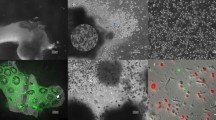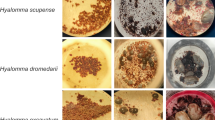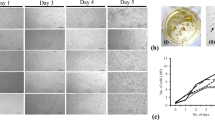Abstract
THE first report on the cultivation of tick (Ixodidae) tissues in vitro was that of Řeháček1 in, Czechoslovakia, who obtained proliferation of fibroblast type cells in explants from developing adults of Dermacentor marginatus. Řeháček2,3 afterwards improved his techniques and was able to obtain cell monolayers by trypsinizing tissues of developing adults of D. marginatus, D. pictus and Hyalomma dromedarii and growing them in test-tubes and Carrol flasks. His methods for preparing tick tissues and of culturing them are fully described elsewhere4.
This is a preview of subscription content, access via your institution
Access options
Subscribe to this journal
Receive 51 print issues and online access
$199.00 per year
only $3.90 per issue
Buy this article
- Purchase on Springer Link
- Instant access to full article PDF
Prices may be subject to local taxes which are calculated during checkout
Similar content being viewed by others
References
Řeháček, J., Acta Virol., 2, 253 (1958).
Řeháček, J., Acta Virol., 6, 188 (1962).
Řeháček, J., Ann. Épiphyties., 14, 199 (1963).
Řeháček, J., J. Med. Entomol. (in the press).
Author information
Authors and Affiliations
Rights and permissions
About this article
Cite this article
VARMA, M., WALLERS, W. An Improved Method for obtaining, in vitro, Uniform Cell Monolayer Sheets from Tissues of the Tick, Hyalomma dromedarii (Ixodidae). Nature 208, 602–603 (1965). https://doi.org/10.1038/208602a0
Issue Date:
DOI: https://doi.org/10.1038/208602a0
This article is cited by
-
Establishment of cell lines from ixodid ticks
Tissue Culture Association Manual (1979)
Comments
By submitting a comment you agree to abide by our Terms and Community Guidelines. If you find something abusive or that does not comply with our terms or guidelines please flag it as inappropriate.



